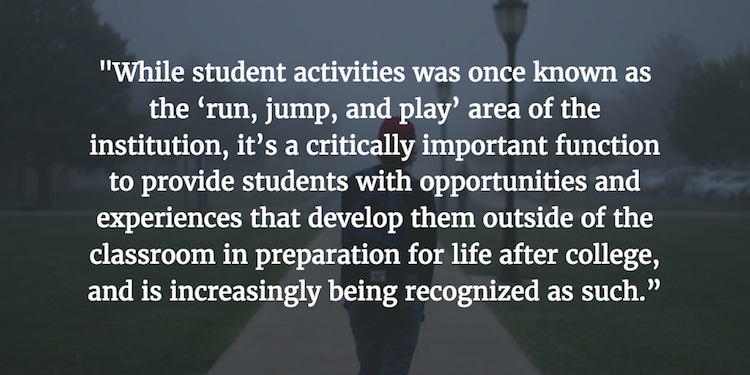As a wide-eyed and energetic graduate student at Texas A&M, I wanted to learn as much about a wide range of institutions as I could.
This passion and curiosity led me to work at small private institutions, large-state institutions, PWIs, and HBCUs focusing on everything from first-year experience programming to leadership education, and from academic advising to res life.
I wanted to gain a deeper understanding of the landscape of student affairs as a whole. Through these experiences, the nuances of each institutional context became clearer, and some overarching trends emerged.
In particular, one persistent narrative has continued to shape my work, especially with student affairs administrators.
That narrative could be best exemplified through a conversation I had with the VPSA at the HBCU where I served as an intern.
He reinforced the importance of the work I was doing in student activities and at the institution, noting the challenges that often exist in working in this functional area. He recognized that “while [student activities] was once known as the ‘run, jump, and play’ area of the institution, it’s a critically important function to provide students with opportunities and experiences that develop them outside of the classroom in preparation for life after college, and is increasingly being recognized as such.”

This conversation left an impression, and while serving on the Board of Directors for the National Association for Campus Activities (NACA), I learned that the sentiments he expressed were shared by many of the members of the Association. To combat this, the Association was making a concerted effort to change the “face” of campus activities. They went so far as to consider different ways that the organization might be better positioned in the higher education landscape to best serve its’ members.
NACA was looking for a way to help their university members clearly articulate the return on engagement of campus activities: to show the way that campus experiences improve specific student outcomes, like GPA and retention, as well as less easily measured effects, like desirability to employers, career readiness, and the development of “soft skills.”
And when I started my first job out of graduate school, I was thankful to land in a department that understood and appreciated the impact that leadership education had on students. They were increasingly able to talk about that impact with data, through measurable increases in GPA, retention, and scholarship maintenance. Reporting to both academic and student affairs, the Center for Student Leadership staff taught credit-bearing courses integrating leadership and civic engagement to undergraduates, advised students in their academic coursework, and contributed as members of the faculty within academic and programmatic discussions.
In my role, I contributed to academic research, grant proposals with faculty members, and co-created programs alongside partners in academic affairs. In fact, I often felt more aligned with academic affairs than the student affairs department on campus.
These experiences inform my view on the value of campus activities, but they aren’t representative of the experiences of Campus Activities personnel as a whole.
When I consider institutions that I’ve worked with, one thing becomes clear about the institutions who have been successful in changing the perception of their work on campus: They’ve changed the narrative around their work by making more clear the impact; the “return on engagement.” They take hold of the narrative around the role that campus activities holds in shaping student experiences, outcomes, and engagement — some institutions even are renaming their departments to represent the outcome of their work (campus engagement) rather than the operational aspect of their work (campus activities).
These institutions acknowledged the tension that can exist between student affairs and academic affairs, and they worked to reframe the tone of the conversation. They shared how they build programs around specific goals and learning outcomes, invited feedback on their curriculum development processes, and they consistently shared outcomes that resulted from their work. Perhaps most importantly, they recognized that the narrative changes one partner at a time, and is earned through a consistent, focused effort.
As you begin to engage with campus stakeholders this year, start conversations with a new framework in mind. Focus on the impact that your work has on students, particularly around a student’s “return on engagement” with campus activities.
The new school year offers an opportunity for a fresh start, whether it’s reflecting on the areas where your programs could improve by building out a set of learning outcomes, or simply coming together with your colleagues to build a shared message. Begin by refreshing yourself on the data that represents the impact of your work, and keep that knowledge in your back pocket to weave into conversations.
Consider these questions to guide your thinking, and take a look at a few others we’ve shared on this blog in the past as well:
- How many students are interacting with your department each week?
- How many students are participating in student organizations?
- How many students are engaging with campus events, and what percent of campus does that represent?
- How does engaging with involvement on campus impact retention? What populations does it disproportionately impact in a positive way?
- What is the average GPA for engaged students? How does that different for students who are not attending, participating in, or more deeply engaged on campus?
- How many hours are students spending in organizational meetings and activities and what are some of the outcomes of those meetings?
- What new skills do students learn by participating in clubs and organizations?
- How are you shaping students prepared for careers through participation in organizations?
- How many students has your department employed, or referred to other campus or off-campus employment, or internships?
Some of these data points are easier to access than others, but don’t let the lack of their existence today excuse not knowing the answer or searching for the answer. To change the narrative, it takes changing people’s minds and confronting their misperceptions of your work — and that takes time and effort.
While it may be discouraging at times, rethinking the way that you represent your processes, goals, and their impact will strengthen relationships and collaboration across the institution, deepen the impact of student engagement, and challenge campus misconceptions of your work.
And if that means you have to pursue more of the data that answers the questions above, it also means strengthening your ability to measure and deliver on the promise and impact that you hope to make with your students as well.





